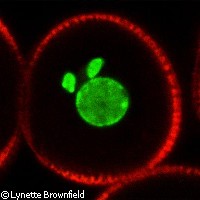Researchers help solve mystery of double fertilisation process in flowering plants
Biologists in Japan, the UK, and the US have discovered that the gene DUO POLLEN1 (DUO1) plays an essential role in the double-fertilisation process of flowering plants. The new study, published in the journal PLoS Genetics, significantly advances our understanding of a process critical to the evolutionary success of flowering plants that has been poorly understood until now. Professor David Twell of the University of Leicester in the UK, who led the study, explained that flowering plants, unlike animals, require not one but two sperm cells for successful fertilisation: 'One sperm cell to join with the egg cell to produce the embryo, and the other to join with the central cell to produce the nutrient-rich ''endosperm'' tissue inside the seed,' he said. According to the study, the central mystery in this double-fertilisation process was 'how each single pollen grain could produce the pair of sperm cells needed for fertility and seed production'. The team studied the Arabidopsis plant, which is commonly studied in plant biology, and discovered that the DUO1 gene plays a critical role in controlling the division of Arabidopsis' precursor reproductive cells into twin sperm cells. In fact, the gene plays a dual role, promoting both the division of sperm precursor cells and their specialised function as sperm cells. Specifically, the researchers showed that DUO1 is required for the production of both a protein that controls cell division and the activation of genes that are required for the differentiation and fertilisation of cells. Effectively, it is responsible for 'switching on' the ability of a plant's sperm cells to fertilise. Moreover, the team found that genes closely related to DUO1 are also found in a wide variety of plants including moss, which suggests that DUO1 could be part of a sperm-cell regulatory network that evolved before the emergence of pollen and flowers. Further research in this area could, the study suggests, 'shed light on the evolution of regulatory mechanisms in plant germline [i.e. germ cell lineage] development and their significance in double fertilisation in flowering plants'. The researchers also hope that further analysis will shed light on how DUO1 activates its targets and how DUO1 itself is activated. Identifying the role of DUO1 in germ cell specification should enable the development of a detailed regulatory network for male gametogenesis (the process by which cells are differentiated into sperm or eggs), they speculate, 'and for comparative studies of the control of sperm cell production'. Taken together with the group's recent description of an independent mechanism for male germ-cell cycle regulation, the current findings significantly advance our understanding of the molecular mechanisms involved in successful plant reproduction and seed production. 'This work provides the first molecular insight into the mechanisms through which cell-cycle progression and gamete differentiation are coordinated in flowering plants,' the study concludes. Professor Twell added that the study could help to unravel the evolutionary origins of plant sperm cells and provide new molecular tools for the manipulation of plant fertility and hybrid seed production. The work could also help to control gene flow in transgenic crops where the male contribution may need to be eliminated ('male sterility' in plants offers some commercial advantages such as longer shelf life for flowers).
Countries
Japan, United Kingdom, United States



